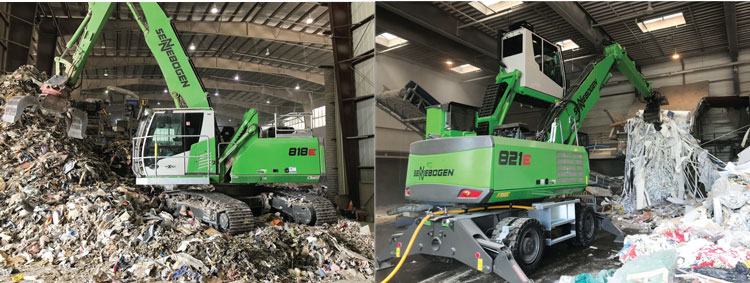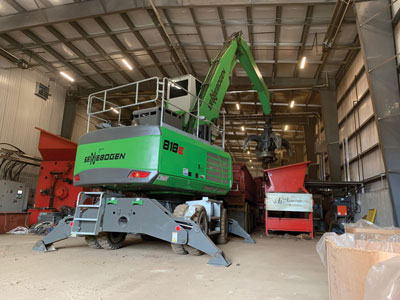Wheel loaders will always be essential equipment for most waste-handling sites. Before you make the switch, look at the wide range of choices available to you, so you can spec the machine that best matches your operation.
By Ryan Kolb
Whether you operate a landfill, MRF or transfer station, every day brings tons of new material that you need to move. In every town and city, fleets of wheel loaders are tasked with making sure the waste stream flows smoothly. But in recent years, many equipment managers are looking to purpose-built material handlers to replace or complement traditional wheel loaders.
These waste handlers can have distinct advantages over other loaders in a wide range of applications. Before you make the switch, let’s look at the wide range of choices available to you, so you can spec the machine that best matches your operation.
Operator Station
A hydraulically elevating cab is one of the most distinctive and valued features of material handlers. Operators are able to rise up to a wide-angle view of the work zone, improving safety for others in the facility. This vantage point provides a direct view into trucks and hoppers for faster, more accurate loading. It also gives a better view of the pile when sorting. Optional features include models that move the cab forward as well as upward. The assembly may also be mounted on pylons for additional height.
Visibility is also enhanced by windows that may be provided on all sides, at floor level and through a skylight. With the addition of safety cameras, the operator has a 360 degree view of the loading area and surrounding traffic. Operators can have added protection from flying debris by installing bulletproof glass and, for severe environments, metal safety grills. Climate-controlled cabs allow all-season comfort for operators and also protects their health with proper air filtration.

Right: The hydraulically elevating operator station allows operators to position with an optimal view of the work zone for faster loader and increased safety for other workers and vehicles in the area.
Undercarriage
In general, material handlers are mounted on crawler tracks, on rubber-tired wheels or on fixed pylons of various heights. Custom mounts may also be available such as rail trucks or gantry frames. Crawlers are often favored for increased traction on soft soils or higher stability working on piles. Units may be equipped with rubber tracks for indoor applications to reduce damage to floors. Wheeled models offer much greater mobility for moving between work zones in a large facility or for easy maneuvering indoors.
Boom and Swing
The boom and stick form the business end of the material handler and is the key to efficiency throughput. While the assembly looks similar to the excavators’, the engineering is quite different due to the focus on lifting and swinging loads versus digging below grade. You will, naturally, have to investigate for the best load capacity and reach for your application. Ask about choice of configurations with optional sticks and pin placements. For operations under a roof, adding limit stops will free operators to lift and move loads quickly, but safely.
The ability to swing loads instead of pushing or carrying is a primary advantage of material handlers over wheel loaders. With a long reach, the waste handler can serve a wide range of loading stations without maneuvering or relocating the whole machine. This ability is especially valuable in busy traffic areas with confined space. For this reason, look for equal load limits through 360 degree of swing, not just the maximum lift in front of the machine.
 Attachments
Attachments
With a quick change coupler, a material handler can be an incredibly versatile addition to any facility’s fleet. Orange-peel grapples sort and load incoming material and pick out potentially hazardous items; buckets to move heavy and wet waste, compost or chips; and lifting magnets pull out ferrous metals to feed a valuable revenue stream. Some machines can even operate scrap shears to reduce oversized items and C&D waste. Some attachments are also equipped with stops and sensors to prevent damage to the floor even at fast loading cycles.
Along with choosing the right attachments, compare machines for power and responsiveness in the hydraulic controls. With advanced systems, operators can use the waste handler like an extension of their own hands to sort materials with surprising speed and agility. Also compare hydraulic filtration systems to ensure consistent performance and to maximize uptime.
Power
Energy use is a significant part of operating costs for waste-handling sites, especially for municipal facilities with little or no offsetting revenues. Tier 4F material handlers achieve a valuable baseline of efficiency, in part due to their ability to move material productively without moving the machine itself. Most waste-handling applications will benefit from an automatic reversing fan that clears dust from the cooling system to keep the engine running optimally.
Electric-drive machines can save significant energy costs over diesel power, depending on access to the grid and on local utility rates. They also yield ongoing savings with less maintenance overhead, lower parts costs, longer service cycles and reduced downtime. Recent innovations provide a choice of mobile electric-drive packages including wheeled units tethered to the power supply by a retractable cable, or “power pack” models that are able to travel longer distances with built-on diesel genset.
Essential Equipment
Wheel loaders will always be essential equipment for most waste-handling sites. However, purpose-built waste handlers have proven they are a valuable alternative for adding safety, production, cost-efficiency and versatility. With today’s range of models and configurations, your equipment dealer can help you match up the right machine to get the most from your waste-handler investment. | WA
Ryan Kolb leads the marketing arm of Sennebogen in the Americas. Since 2003, Sennebogen has emerged as a leading OEM of purpose-built material handlers. Well-known for its advocacy for new standards of safety, productivity and cost savings in the industry, Sennebogen is widely respected for its onsite connections in the field with customers operating material handlers in scrap recycling, waste processing, barge facilities, log handling and tree care applications. For more information, call (704) 347-4910, e-mail [email protected] or visit www.sennebogen-na.com.
